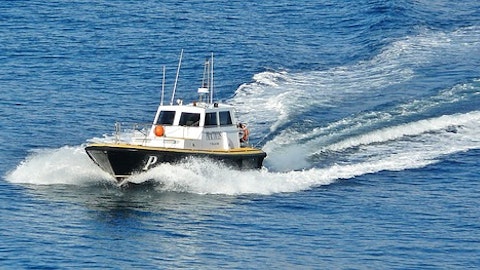Ryan Gwillim: Yeah. James, maybe I’ll start with that and then Dave can fill in. Yeah. The — it’s always interesting when you come out with a downside scenario, you got to live with it kind of in perpetuity. But we knew that we would get this question obviously on the call this morning. The difference really is kind of two things. One’s the starting point. If you remember, this was a one-year scenario that we came out with in 2022 at a time where we were coming off a kind of a $10 EPS number or had a $10 budget, excuse me, for 2022 EPS and we were anticipating what would happen if the world dropped off in one year. That year also had some pipeline fill in it where Boat Group, although the retail sales would drop off, I think, we said 30% or 35%, that retail, that the wholesale would actually hold in a little better.
This, as we said today, the real difference is two, one, there is no pipeline refill remaining in boats or engines. But two, really the P&A businesses as a whole, they haven’t performed any different than we anticipated, but they have performed a little different from a starting point. If you remember, really peak P&A season was end of 2021 and into 2022. And despite still having a CAGR of kind of 8%, 9% over the last five years, that business has come off a little bit from a high, really those two years that we gave the downside scenario. So if you take the midpoint of our range kind of at $7.50 [ph], you probably got a little bit of goodness on propulsion, a little trailing on P&A. Shares are obviously a good guy, because we’ve been buying back a little more.
And then the last thing I’d say was an investment really in the ACES, in all of our ACES categories that has driven about maybe $0.40, $0.50 of cost, but we’re obviously happy to do that. So that’s really the difference.
Operator: Our next question is from Mike Swartz with Truist Securities. Please proceed.
Mike Swartz: Hey, guys. Just wanted to touch on the Propulsion guidance, and more specifically, just the margin assumptions. It looks like you are kind of embedding in that guidance about 16% margins, which is a step down of about 200 basis points. From the commentary you provided on the call, it sounds like mix, both product mix and channel mix should be positives. Just help us walk through how you get to that 200 basis point decline.
Ryan Gwillim: Hey. Good morning, Mike. Yeah. Again, this is one that we kind of knew would get folks attention. It really starts with absorption just due to lower volume. If you look on the EPS bridge, you noted the pipeline, the lack of pipeline fill being a big driver on EPS and a chunk of that is obviously volume and sales related, but that also hurts absorption in the facility, certainly in the Fond du Lac facility with lower volume. So absorption is certainly the number one. Tariffs is number two, about $15 million more of tariffs and that just goes right to COGS. And we’re doing our best to offset it by doing other things and where we do final assembly, but it’s still $15 million is hard to cover. And then, if we are in a position where input costs, material and labor are elevated a little bit over prior year, not a terrible amount, but our ability to price over that, although positive, so price, PNOC [ph] price over input cost is still positive.
The spread there, the available price over input cost is not as large. So the goodness is not as large. Those three things are really the primary drivers and they’re really all in gross margin. I would note that as per usual, Mercury does a fantastic job of monitoring their cost structure and their OpEx is targeted to be relatively flat year-over-year and that’s inclusive of absorbing all the OpEx from Flite, which is the October acquisition, obviously, and a resetting of comp back to target levels.
Mike Swartz: Okay. That’s helpful. Thank you, Ryan. And maybe just a second question, as we think about the lower end of the earnings range and the higher end of the range, maybe walk us through maybe the big four or five factors driving that. How do you get to the top end? How do you get to the bottom end?
Dave Foulkes: I think, Mike, just one addition to the previous point is that, the absorption issue really over-indexes towards Q1, because we don’t want to get rid of people, line operators in Q1 that we’re going to need in Q2. So there’s a kind of compounding effect in Q1 that will normalize through the other quarters in the year. In terms of top and bottom of the range, I think, bottom of the range would have to be further macro weakness than we anticipate. If retail sales hang in at roughly flat to last year, it’s difficult to see the bottom of the range. But we don’t need a lot of kind of market tailwind to get above the midpoint, really. I think our assumption of wholesale boat units, actually production going down this year in terms of being about 1,000 units below retail is probably a bit on the pessimistic side and then especially with the cost reductions that we will implement in any market scenario that we’ve already described, I think, that will help our leverage on particularly benefit EPS.
So I would say downside would have to be additional macro risk of some kind. Upside is a bit better tailwind from the market.
Mike Swartz: Okay. Thank you.
Operator: Our next question is from Megan Alexander with Morgan Stanley. Please proceed.
Megan Alexander: Hi. Yeah. I don’t want to belabor it, but just did have a follow-up on that Propulsion margin answer if I could. Everything you said makes sense, but if I sit here and take kind of that $15 million tariff out, just to kind of look apples-to-apples versus last year, I’m still getting somewhere in the range of 45%-ish decremental margins. I think you’ve historically kind of talked about volume deleverage in the 20% to 30% range. So can you just maybe help us understand the discrepancy there, because it just seems pretty large.



